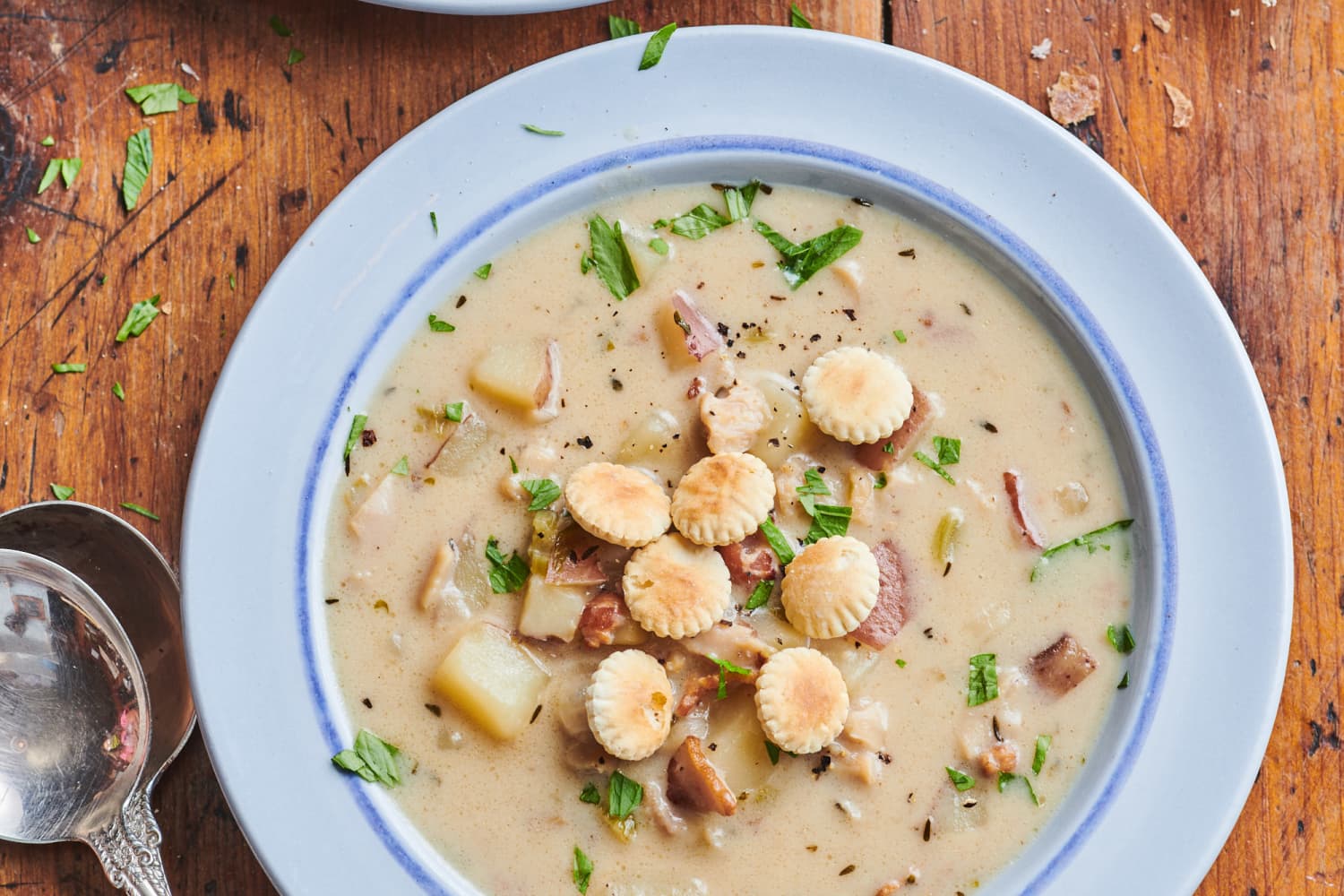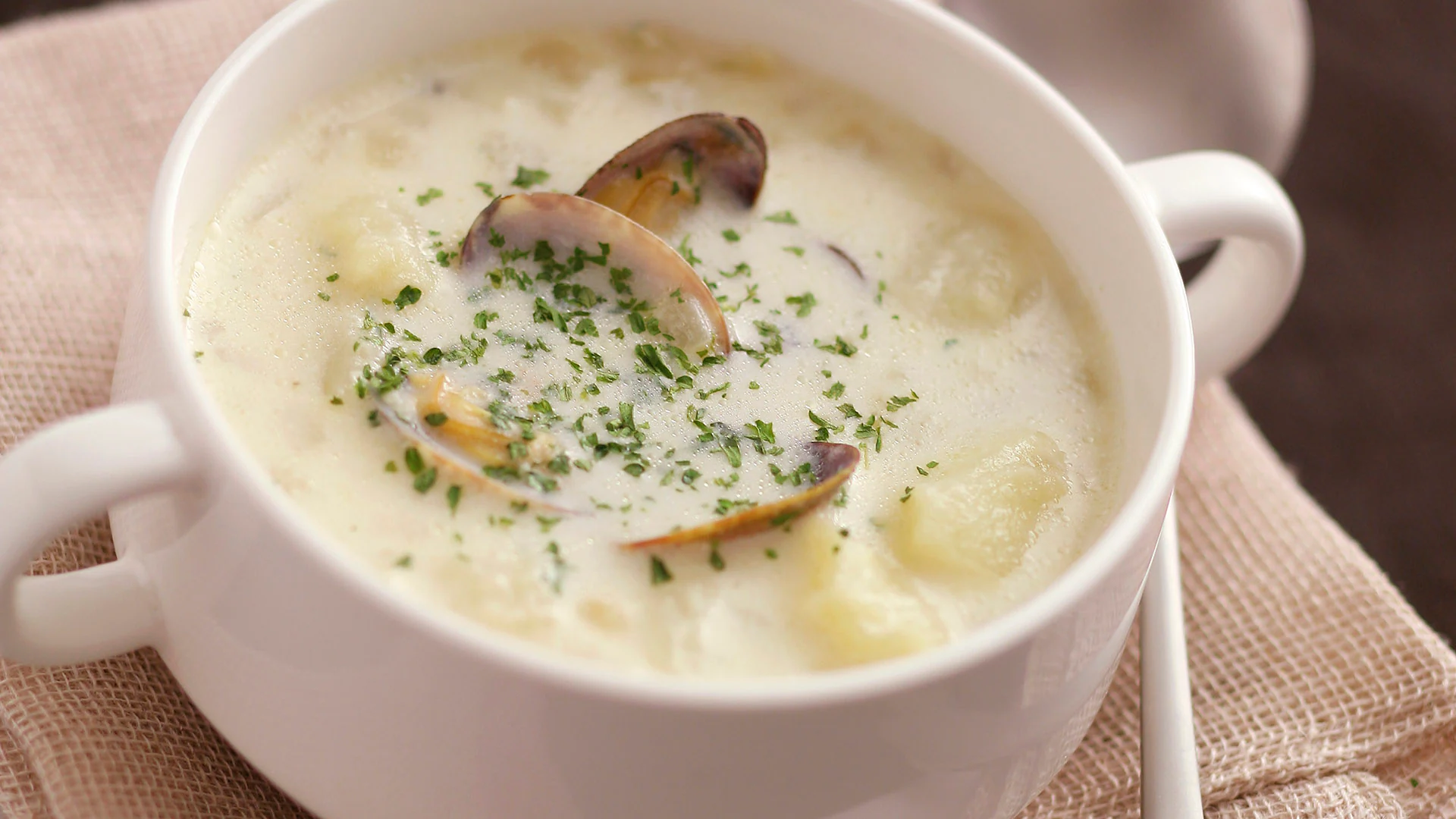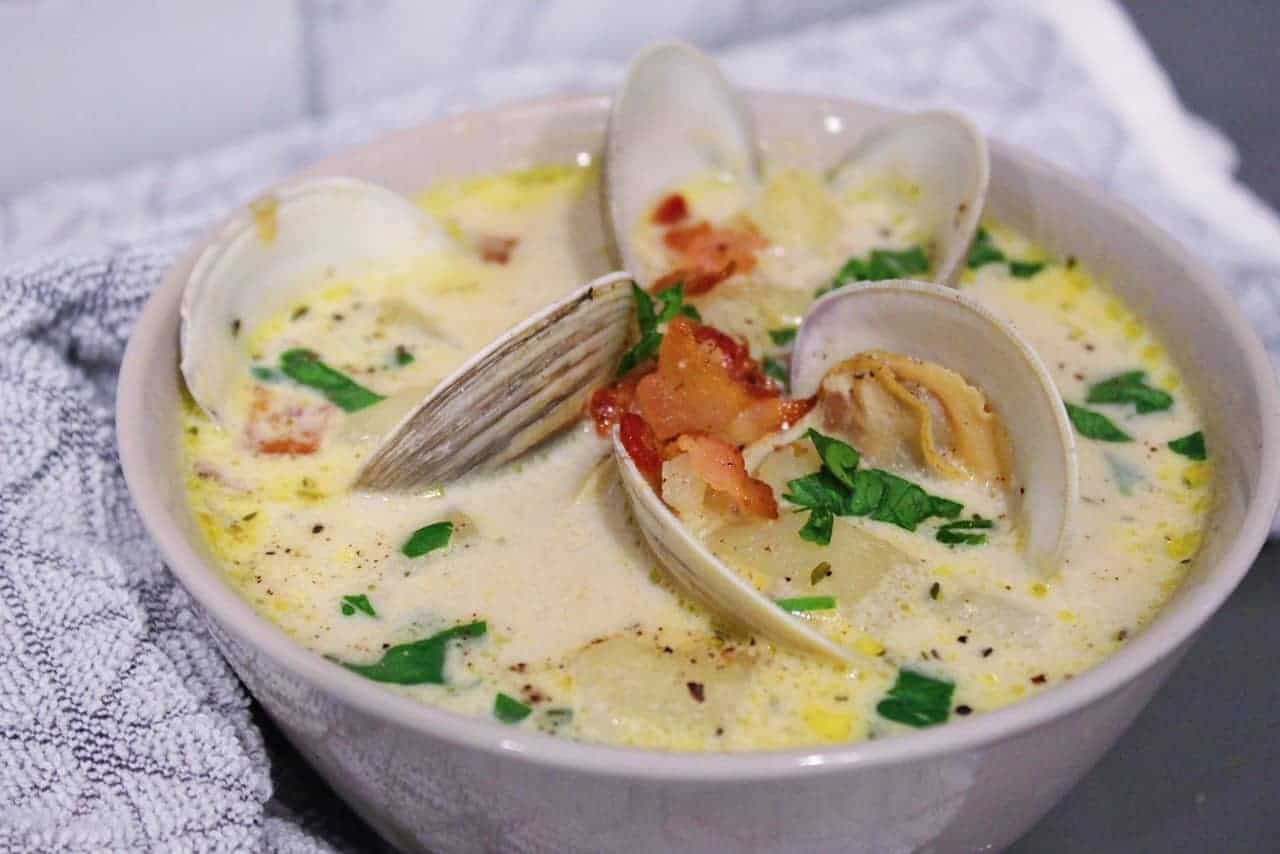Clam chowder stands as a culinary icon in American cuisine, beloved for its creamy texture, hearty ingredients, and rich flavors. This classic dish has a fascinating history that mirrors the cultural tapestry of the regions where it thrives. Join us on a journey through the origins, variations, and enduring popularity of clam chowder.

Origins and History: The roots of clam chowder trace back to early American settlements along the Eastern seaboard, particularly in regions like New England. Historically, it was a simple, hearty soup prepared by coastal communities, utilizing ingredients readily available in their surroundings. Native American tribes, such as the Wampanoag and Narragansett, introduced settlers to the concept of clam-based soups, laying the foundation for what would become clam chowder.
New England Clam Chowder: New England-style clam chowder reigns supreme among clam chowder varieties. Renowned for its creamy base, chunks of tender clams, diced potatoes, onions, and sometimes bacon, it’s a comforting delicacy that warms the soul, especially on chilly evenings. Traditional recipes emphasize the use of fresh ingredients sourced from local waters, maintaining a connection to the dish’s maritime origins.
Manhattan Clam Chowder: In contrast to its creamy counterpart, Manhattan clam chowder boasts a vibrant, tomato-based broth enriched with vegetables such as carrots, celery, and tomatoes. This variation originated in the Italian-American communities of New York City, reflecting the influence of Mediterranean flavors on American cuisine. With its zesty tang and robust profile, Manhattan clam chowder offers a refreshing departure from the creaminess of its New England cousin.
Regional Variations: Beyond the classic New England and Manhattan styles, clam chowder exhibits an array of regional adaptations across the United States. From the creamy, dairy-free variations of Rhode Island to the spicy Cajun twists found in Louisiana, each rendition reflects the local culinary preferences and cultural influences of its surroundings. Whether thick or thin, creamy or tomato-based, clam chowder continues to evolve, incorporating diverse ingredients and culinary techniques.
Modern Interpretations: In contemporary gastronomy, chefs and home cooks alike experiment with clam chowder, infusing it with innovative twists while staying true to its essence. Some incorporate exotic seafood like lobster or scallops for a luxurious touch, while others introduce global flavors through spices and seasonings. Vegan and gluten-free versions cater to dietary preferences, ensuring that clam chowder remains accessible to all.
:max_bytes(150000):strip_icc()/Manhattan-Clam-Chowder-FT-RECIPE0622-bab2ddf7197f408298563584b1507b5b.jpg)
Here’s a classic recipe for New England-style clam chowder:
Ingredients:
- 4 slices of bacon, chopped
- 1 onion, finely chopped
- 2 stalks of celery, finely chopped
- 2 cloves of garlic, minced
- 3 tablespoons all-purpose flour
- 3 cups chicken or vegetable broth
- 1 bay leaf
- 1 pound Yukon Gold potatoes, diced into 1/2-inch cubes
- 2 cups chopped clams, fresh or canned (with juices)
- 1 cup heavy cream
- Salt and pepper to taste
- Fresh parsley, chopped (for garnish)
- Oyster crackers (for serving, optional)
Instructions:
- In a large pot or Dutch oven, cook the chopped bacon over medium heat until crispy. Remove the bacon with a slotted spoon and set aside, leaving the bacon drippings in the pot.
- Add the chopped onion and celery to the pot with the bacon drippings. Cook, stirring occasionally, until the vegetables are softened, about 5 minutes. Add the minced garlic and cook for an additional 1-2 minutes until fragrant.
- Sprinkle the flour over the cooked vegetables and stir to coat. Cook for 2-3 minutes to remove the raw flour taste.
- Gradually pour in the chicken or vegetable broth, stirring constantly to prevent lumps from forming. Add the bay leaf and diced potatoes to the pot. Bring the mixture to a simmer and cook until the potatoes are tender, about 10-15 minutes.
- Once the potatoes are cooked, add the chopped clams (with their juices) to the pot. Stir in the heavy cream and cooked bacon. Season with salt and pepper to taste.
- Continue to simmer the chowder for an additional 5-10 minutes to allow the flavors to meld together and the chowder to thicken slightly. Adjust the seasoning if necessary.
- Remove the bay leaf from the chowder and discard. Ladle the clam chowder into bowls and garnish with chopped fresh parsley. Serve hot with oyster crackers on the side, if desired.
Here are some interesting facts about clam chowder:
- Colonial Origins: Clam chowder has its roots in early American colonial times, where it was a staple dish among coastal communities. It was often made with simple ingredients like clams, onions, and potatoes, reflecting the availability of ingredients in the region.
- Name Origins: The word “chowder” is believed to have originated from the French word “chaudière,” which refers to a cooking pot or cauldron. Over time, the dish evolved into what is now known as clam chowder.
- Regional Varieties: While New England clam chowder is the most well-known variety, there are several regional variations across the United States. Manhattan clam chowder features a tomato-based broth, while Rhode Island clam chowder is clear and broth-based, omitting dairy altogether.
- Legal Dispute: In 1939, a bill was introduced in the Maine legislature that would have made it illegal to add tomatoes to clam chowder. This was a response to the growing popularity of Manhattan clam chowder, which was seen as a threat to the traditional New England recipe. The bill, however, was never passed.
- Cultural Significance: Clam chowder holds cultural significance in regions where it is popular. In New England, it is often served at traditional gatherings and events, such as clambakes and seafood festivals, while in New York City, Manhattan clam chowder is celebrated as a symbol of the city’s diverse culinary heritage.
- International Appeal: Clam chowder has gained popularity beyond the shores of the United States and is enjoyed in various parts of the world. It has inspired similar dishes in countries like Canada, where “Maritime” or “Atlantic” clam chowder is a beloved comfort food.
- Health Benefits: Clams, the primary ingredient in clam chowder, are a good source of protein, vitamins, and minerals, including iron and zinc. Additionally, clam chowder often contains vegetables like potatoes and celery, adding to its nutritional value.
- Pop Culture References: Clam chowder has made appearances in various forms of media, including literature, film, and television. It is often used as a symbol of comfort and home-cooked meals, evoking feelings of warmth and nostalgia.
- Annual Celebrations: Some regions host annual clam chowder festivals to celebrate this beloved dish. These events often feature competitions where chefs and home cooks compete to create the best clam chowder recipe.
- Versatility: While traditional clam chowder recipes remain popular, chefs and home cooks often put their own spin on the dish, incorporating different ingredients and flavors. This versatility allows clam chowder to adapt to different tastes and preferences while maintaining its timeless appeal.
Here are some frequently asked questions (FAQs) about clam chowder:
What is clam chowder?
The most common component of clam chowder, a stew or soup, are the clams themselves. The characteristic creaminess or brothiness of the dish is enhanced by the addition of flavors such as potatoes, onions, celery, and occasionally bacon.
What are the main types of clam chowder?
Manhattan clam chowder and New England clam chowder are the two most common varieties. Creamy New England clam chowder is made with milk or cream, whereas tomato-based broth is used in Manhattan clam chowder.
What are the key ingredients in clam chowder?
Claims, potatoes, onions, celery, and a tomato-based broth, cream, or milk are the mainstays of clam chowder. Some other possible additions are bay leaves, thyme, garlic, and bacon.
Are there variations of clam chowder?
Rhode Island clam chowder is transparent and broth-based, whereas Menorcan clam chowder is flavored with datil peppers; both are examples of the many regional varieties of clam chowder. By combining new ingredients or enhancing existing flavors, some chefs also manage to come up with distinctive variants.
Is clam chowder gluten-free?
One possible gluten-containing ingredient in traditional clam chowder recipes is flour, used to thicken the soup. However, gluten-free options can be achieved by substituting corn flour or gluten-free flour blends for the traditional thickening agents.
Can I use canned clams in clam chowder?
In clam soup, yes, canned clams will work just fine. They are a favorite among home cooks since they are easy to find and use. If you want a more authentic flavor, though, you can use fresh clams instead.
How long does clam chowder last in the refrigerator?
Refrigerated clam chowder, if sealed properly, will keep for three to four days. To avoid spoiling, cool the chowder rapidly and keep it at the right temperature.
Can clam chowder be frozen?
Yes, clam chowder can be frozen for longer storage. It is best to freeze clam chowder in individual portions in airtight containers or freezer bags. When reheating, thaw the chowder in the refrigerator overnight and then heat it gently on the stove or in the microwave.
How can I thicken clam chowder?
Clam chowder can be thickened by adding a roux (a mixture of flour and fat), cornstarch slurry, or by pureeing some of the potatoes or vegetables in the chowder. Be sure to cook the chowder for a few extra minutes after thickening to allow the flavors to meld.
Is clam chowder a healthy meal option?
While clam chowder made with fresh ingredients and minimal butter and cream might be a healthy choice, it’s important to be aware that it can be heavy in sodium and calories. To make it a healthy alternative, try using lighter ingredients or reducing the amount size.

Conclusion:
Not only does clam chowder taste great, but it also brings back fond memories of simpler times and the comforts of home. The essence of American comfort cuisine is encapsulated in clam chowder, which is consumed either by the seaside in New England or in a busy city diner. This classic meal, which has changed and adapted throughout the years, is a constant reminder of the diverse and varied culinary traditions that have shaped our tastes and brought us together as a nation.






